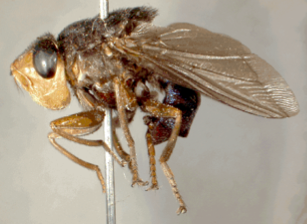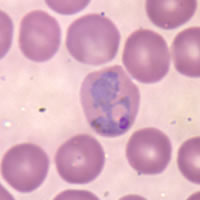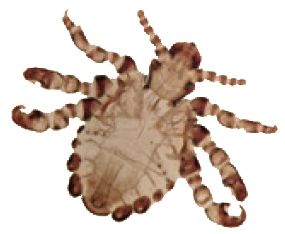 W
WBertiella is a genus of cestode tapeworm parasites that primarily infects nonhuman primates, rodents and Australian marsupials. Infections by Bertiella are known as bertielliasis. Occasional human infections have been documented by one of two species: Bertiella studeri, or Bertiella mucronata. Bertiella transmission is through oribatid mites that are present in the soil of problem areas, and can be easily prevented by avoiding contact with nonhuman primates, rodents and soil in these areas.
 W
WThe human botfly, Dermatobia hominis, is one of several species of flies, the larvae of which parasitise humans. It is also known as the torsalo or American warble fly, though the warble fly is in the genus Hypoderma and not Dermatobia, and is a parasite on cattle and deer instead of humans.
 W
WOesophagostomum is a genus of parasitic nematodes of the family Strongylidae. These worms occur in Africa, Brazil, China, Indonesia and the Philippines. The majority of human infection with Oesophagostomum is localized to northern Togo and Ghana. Because the eggs may be indistinguishable from those of the hookworms, the species causing human helminthomas are rarely identified with accuracy. Oesophagostomum, especially O. bifurcum, are common parasites of livestock and animals like goats, pigs and non-human primates, although it seems that humans are increasingly becoming favorable hosts as well. The disease they cause, oesophagostomiasis, is known for the nodule formation it causes in the intestines of its infected hosts, which can lead to more serious problems such as dysentery. Although the routes of human infection have yet to be elucidated sufficiently, it is believed that transmission occurs through oral-fecal means, with infected humans unknowingly ingesting soil containing the infectious filariform larvae.
 W
WPedicinus is a genus of sucking louse, the only genus in the family Pedicinidae. Species belonging to this genus are found on Old World monkeys and apes of different kinds. Pedicinus, along with its sister genus Pthirus, are believed to have diverged from their common ancestor approximately 22.5-2.5 million years ago.
 W
WPedicinus hamadryas is a species of sucking louse. Its typical host is the baboon .
 W
WThe pinworm, also known as threadworm or seatworm, is a parasitic worm. It is a nematode (roundworm) and a common intestinal parasite or helminth, especially in humans. The medical condition associated with pinworm infestation is known as pinworm infection (enterobiasis) or less precisely as oxyuriasis in reference to the family Oxyuridae.
 W
WPlasmodium knowlesi is a parasite that causes malaria in humans and other primates. It is found throughout Southeast Asia, and is the most common cause of human malaria in Malaysia. Like other Plasmodium species, P. knowlesi has a life cycle that requires infection of both a mosquito and a warm-blooded host. While the natural warm-blooded hosts of P. knowlesi are likely various Old World monkeys, humans can be infected by P. knowlesi if they are fed upon by infected mosquitoes. P. knowlesi is a eukaryote in the phylum Apicomplexa, genus Plasmodium, and subgenus Plasmodium. It is most closely related to the human parasite Plasmodium vivax as well as other Plasmodium species that infect non-human primates.
 W
WThe Plasmodium species infecting primates include the parasites causing malaria in humans.
 W
WPthirus gorillae or gorilla louse is a species of parasitic sucking louse that afflicts gorillas. It is found in the African continent, specifically in Rwanda and Democratic Republic of the Congo. Pthirus gorillae and Pthirus pubis are the only known species that belong to the genus Pthirus, often incorrectly spelled as Phthirus. It is suggested that it is transmitted among its hosts by social grooming, shared bedding and sexual contact.